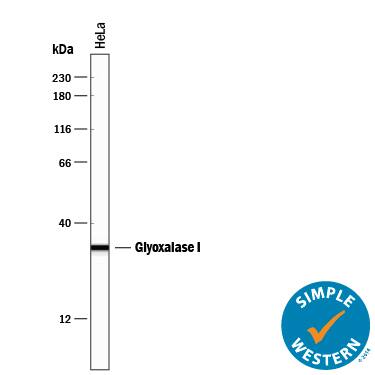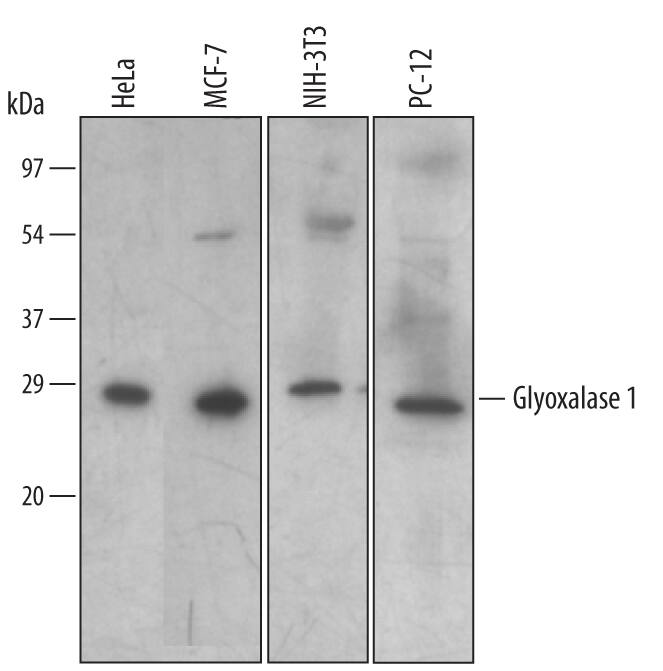Human/Mouse/Rat Glyoxalase I Antibody
R&D Systems, part of Bio-Techne | Catalog # AF4959

Key Product Details
Species Reactivity
Applications
Label
Antibody Source
Product Specifications
Immunogen
Ala2-Met184
Accession # Q04760
Specificity
Clonality
Host
Isotype
Scientific Data Images for Human/Mouse/Rat Glyoxalase I Antibody
Detection of Human/Mouse/Rat Glyoxalase I by Western Blot.
Western blot shows lysates of HeLa human cervical epithelial carcinoma cell line, MCF-7 human breast cancer cell line, NIH-3T3 mouse embryonic fibroblast cell line, and PC-12 rat adrenal pheochromocytoma cell line. PVDF membrane was probed with 1 µg/mL of Goat Anti-Human/Mouse/Rat Glyoxalase I Antigen Affinity-purified Polyclonal Antibody (Catalog # AF4959) followed by HRP-conjugated Anti-Goat IgG Secondary Antibody (Catalog # HAF109). A specific band was detected for Glyoxalase I at approximately 28 kDa (as indicated). This experiment was conducted using Immunoblot Buffer Group 2.Detection of Human Glyoxalase I by Simple WesternTM
Simple Western lane view shows lysates of HeLa human cervical epithelial carcinoma cell line, loaded at 0.2 mg/mL. A specific band was detected for Glyoxalase I at approximately 33 kDa (as indicated) using 50 µg/mL of Goat Anti-Human/Mouse/Rat Glyoxalase I Antigen Affinity-purified Polyclonal Antibody (Catalog # AF4959) followed by 1:50 dilution of HRP-conjugated Anti-Goat IgG Secondary Antibody (Catalog # HAF109). This experiment was conducted under reducing conditions and using the 12-230 kDa separation system.Applications for Human/Mouse/Rat Glyoxalase I Antibody
Simple Western
Sample: HeLa human cervical epithelial carcinoma cell line
Western Blot
Sample: HeLa human cervical epithelial carcinoma cell line, MCF-7 human breast cancer cell line, NIH-3T3 mouse embryonic fibroblast cell line, and PC-12 rat adrenal pheochromocytoma cell line
Formulation, Preparation, and Storage
Purification
Reconstitution
Formulation
Shipping
Stability & Storage
- 12 months from date of receipt, -20 to -70 °C as supplied.
- 1 month, 2 to 8 °C under sterile conditions after reconstitution.
- 6 months, -20 to -70 °C under sterile conditions after reconstitution.
Background: Glyoxalase I
Glyoxalase I (also lactoylglutathione lyase, methylglyoxalase, and glx I) is a 21 kDa member of the Glyoxalase I family. The enzyme is an isomerase that catalyzes the formation of S-D-lactoylglutathione from the hemimercaptal adduct that forms spontaneously between methylglyoxal and reduced GSH (1‑4). The monomeric subunit for human Glyoxalase I is 184 amino acids (aa) in length. In the mature protein, the methionine at the N-terminus is removed. Human Glyoxalase I exists in three separable isoforms as homo-and hetero-dimers of two allelic subunit variants, which differ in charge (1). The isoforms are formed when residue 19 is changed from cysteine to tyrosine and residue 111 is changed from glutamine to alanine. Each subunit binds one Zn2+ atom (1, 3‑4). The protein is made up of multiple beta strands and alpha helical regions. Human Glyoxalase I shares 91% and 90% aa sequence identity with rat and mouse Glyoxalase I, respectively. The enzyme is ubiquitously expressed and is also present in many tumor cell lines, in which its concentration is often upregulated (1). The biological role of the enzyme remains unclear, but the glyoxalase system detoxifies the precursors of advanced glycation end products, which take part in the pathogenesis of vascular, diabetic, and uremic complications (5).
References
- Ridderstrom, M. & B. Mannervik (1996) Biochem. J. 314:463.
- Marmstal, E. & B. Mannervik (1981) FEBS Lett. 131:301.
- Kim, N-S. et al. (1993) J. Biol. Chem. 268:11217.
- Ranganathan, S. et al. (1993) J. Biol. Chem. 268:5661.
- Kalousova, M. et al. (2007) Ann. N. Y. Acad. Sci. 1126:268.
Alternate Names
Gene Symbol
UniProt
Additional Glyoxalase I Products
Product Documents for Human/Mouse/Rat Glyoxalase I Antibody
Product Specific Notices for Human/Mouse/Rat Glyoxalase I Antibody
For research use only

